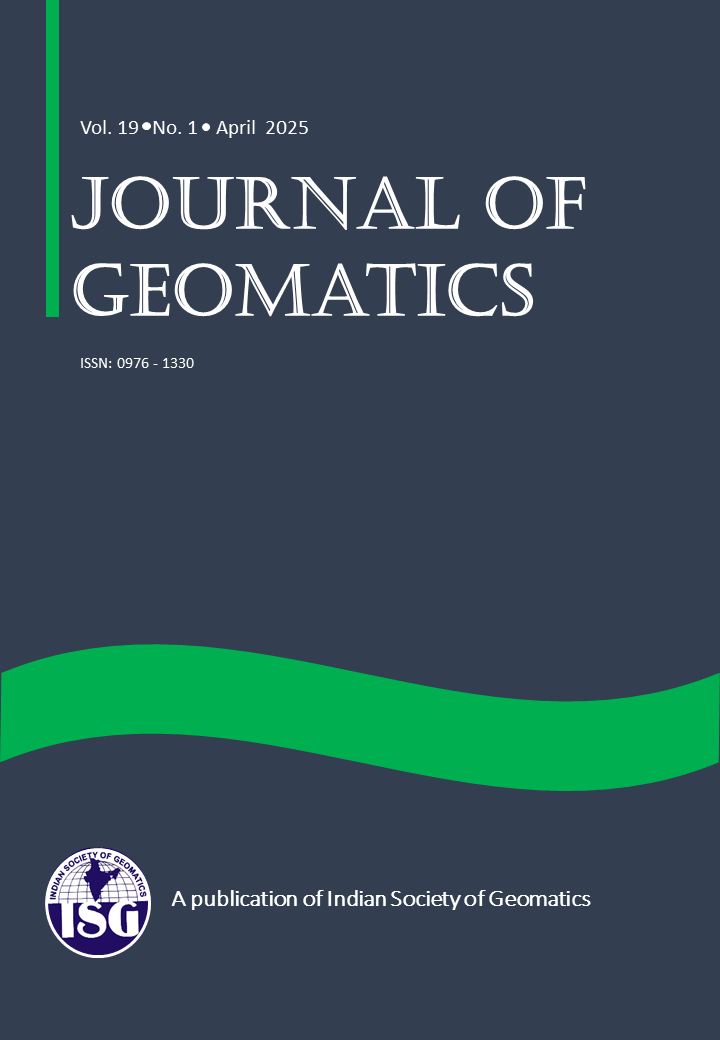Predicting current and future habitat suitability of Cullenia exarillata A. Robyns – An endemic and keystone species of the Western Ghats
DOI:
https://doi.org/10.58825/jog.2025.19.1.211Keywords:
Biodiversity, Species, Habitat, Climate change, Western GhatsAbstract
Accurate prediction of habitat suitability is crucial for species of conservation importance. Predictive distribution models play a key role in conservation by identifying current and future suitable habitat. Cullenia exarillata A. Robyns is an endemic and keystone tree species of the tropical wet evergreen forests of the Western Ghats of India. This study used a species distribution model to predict the current and future distribution of Cullenia exarillata. Various environmental variables and the MaxEnt model were used to assess the current potential distribution and shifts within different shared socio-economic pathways. The findings illustrate the potential reduction of the species ecological niche in certain landscapes of Karnataka, Kerala and Tamil Nadu under future climate change scenarios. The receiver operating characteristic area under the curve was used to evaluate the accuracy of the model. The Jackknife test was used to assess the significance of environmental factors. This study highlights the importance of targeted conservation and habitat management strategies for the conservation of Cullenia exarillata. This spatial approach can be applied to other species facing similar threats, making it an essential tool for broader conservation efforts.
References
Andrews, T. et al. (2019). Forcings, feedbacks, and climate sensitivity in HadGEM3-GC3.1 and UKESM1. J.Adv. Model. Earth Syst. 11, 4377-4394.
Araújo, M. B. and A.T. Peterson (2012). Uses and misuses of bioclimatic envelope modeling. Ecology, 93(7), 1527-1539.
Bellard, C., C. Bertelsmeier, P. Leadley, W. Thuiller and F. Courchamp (2012). Impacts of climate change on the future of biodiversity. Ecol. Lett., 15(4), 365-377.
Devy, M.S. and P. Davidar (2003). Pollination systems of trees in Kakachi, a mid-elevation wet evergreen forest in Western Ghats, India. Am. J. Bot, 90(4), 650-657.
Devy, M.S. (2006). Effects of fragmentation on a keystone tree species in the rainforest of Kalakad-Mundanthurai Tiger Reserve, India. Technical Report. Ashoka Trust for Research in Ecology and the Environment, Bangalore.
Dutta, K., C.S. Reddy, S. Sharma and C.S. Jha (2016). Quantification and monitoring of forest cover changes in Agasthyamalai Biosphere Reserve, Western Ghats, India (1920-2012). Curr. Sci. 110(4), 508-520.
Elith, J., and J.R. Leathwick (2009). Species distribution models: Ecological explanation and prediction across space and time. Annu. Rev. Ecol. Evol. Syst., 40, 677-697.
Elith, J., S.J. Phillips, T. Hastie, M. Dudík, Y.E. Chee and C.J. Yates (2011). A statistical explanation of MaxEnt for ecologists. Divers. Distrib., 17(1), 43-57.
Fielding, A. H., and J.F. Bell (1997). A review of methods for the assessment of prediction errors in conservation presence/absence models. Environ Conserv. 24(1), 38-49.
Fick, S.E., and R.J. Hijmans (2017). WorldClim 2: New 1-km spatial resolution climate surfaces for global land areas. Int. J. Climatol. 37(12), 4302-4315.
Franklin, J. (2013). Species distribution models in conservation biogeography: Developments and challenges. Divers. Distrib., 19(10), 1217-1223.
Ganesh, T. and P. Davidar (2001). Dispersal modes of tree species in the wet forests of southern Western Ghats. Curr. Sci. 80(3), 394-399.
IPCC (2014). Climate Change 2014: Synthesis Report. Contribution of Working Groups I, II, and III to the Fifth Assessment Report of the Intergovernmental Panel on Climate Change. IPCC, Geneva, Switzerland, 151 pp.
KFRI (2016). Seed ecological and regeneration studies on keystone tree species of the evergreen and moist deciduous forest ecosystems. Technical Report. Kerala Forest Research Institute, Peechi. ISSN 0970-8103.
Malik, K., K.R.L. Saranya, C.S. Reddy and A.O. Varghese (2022). Predicting the habitat suitability of Dipterocarpus indicus – An endemic and endangered species in the Western Ghats, India. Spat. Inf. Res, 30 (5), 617-632.
Myers, N. et al. (2000). Biodiversity hotspots for conservation priorities. Nature, 403(6772), 853-858.
Namitha, L.H., A.L. Achu, C.S. Reddy and Suhara Beevy. (2022). Ecological modelling for the conservation of Gluta travancorica Bedd. - An endemic tree species of southern Western Ghats, India. Ecol. Inform., 71, 101823.
Phillips, Steven J. (2005). A brief tutorial on Maxent. At&t Research, 190.4: 231-259.
Raman, T.R.S., G.S. Rawat and A.J.T. Johnsingh (2010). Consequences of long-term habitat fragmentation on trees and their regeneration dynamics in tropical rainforests of the Western Ghats, India. Conserv. Biol., 24(3), 1089-1098.
Reddy, C.S., C.S. Jha, C.S. and V.K. Dadhwal (2016). Assessment and monitoring of long-term forest cover changes (1920-2013) in Western Ghats biodiversity hotspot. J. Earth Syst. Sci. 125(1), 103-114.
Reddy, C.S., C.S. Jha, C.S. and V.K. Dadhwal (2018). Earth Observations based conservation prioritization in Western Ghats, India. J. Geol. Soc. India 92(5), 562–567.
Reddy, C.S., A. Jospeh, Abraham, G.A. and M.M. Sabu (2021). Patterns of animal and plant discoveries, distribution and endemism in India - Implications on effectiveness of the protected area network. Environ. Monit. Assess. 193, 62.
Roy, P.S., S.P.S. Kushwaha, M.S.R. Murthy, A. Roy, D. Kushwaha, C.S. Reddy, M.D. Behera, H. Padalia, V.B. Mathur, S. Singh, C.S. Jha and M.C. Porwal (2012). Biodiversity Characterisation at Landscape Level: National Assessment. Indian Institute of Remote Sensing, Dehra Dun. pp 1-254. ISBN 81-901418-8-0.
Satish, K.V., K.R.L. Saranya, C.S. Reddy, P. Harikrishna, C.S. Jha and P.V.V. Prasada Rao (2014). Geospatial assessment and monitoring of historical forest cover changes in Nilgiri Biosphere Reserve, Western Ghats, India (1920-2012). Environ. Monit. Assess. 186(12), 8125-8140.
Swets, J.A. (1988). Measuring the accuracy of diagnostic systems. Science, 240, 1285-1293.
Thomas, C.D. et al. (2017). Climatologies at high resolution for the earth’s land surface areas. Sci. Data, 4(1), 170122.
Vattakaven, T., R. George, D. Balasubramanian, M. Réjou-Méchain, G. Muthusankar, B. Ramesh and R. Prabhakar (2016) India Biodiversity Portal: An integrated, interactive and participatory biodiversity informatics platform. Biodivers. Data J 4: e10279. https://doi.org/10.3897/BDJ.4.e10279.
Yang, H., and Y. Zhao (2013). Smoothed jackknife empirical likelihood inference for the difference of ROC curves. J. Multivar. Anal., 115, 270-284.
Downloads
Published
How to Cite
Issue
Section
License
Copyright (c) 2025 Journal of Geomatics

This work is licensed under a Creative Commons Attribution-NonCommercial 4.0 International License.



